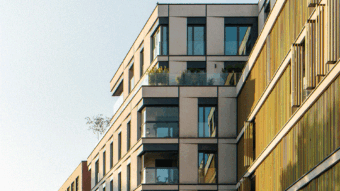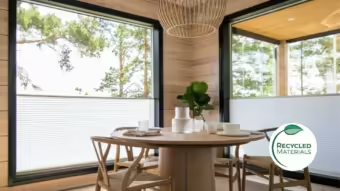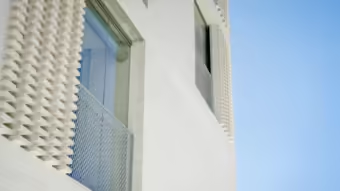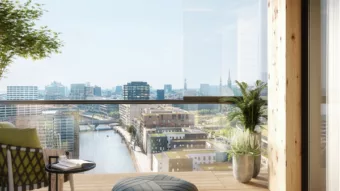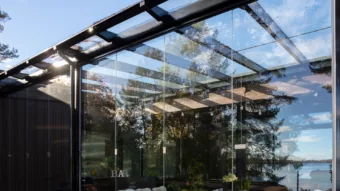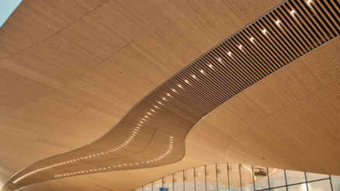
News & Events
Read the latest Lumon International news
-
[NEWS] Lumon publishes Annual Review: Strengthening the foundation for the future
Read more…Lumon Group has published its Annual Review 2024, showcasing a year marked by resilience, strategic investments, and a strong commitment to sustainability.
-
[NEWS] Glazed balconies on the rise in Poland: Lumon strengthens presence with standout residential projects
Read more…Balcony glazing is fast becoming a hallmark of modern Polish residential architecture. Two years after establishing its subsidiary in Poland, Lumon – a global leader in frameless balcony glazing solutions – has successfully completed several high-profile residential projects, transforming urban living in cities like Warsaw, Łódź, and Pruszków.
-
[NEWS] Visor launches a groundbreaking blinds collection with unique sustainability features
Read more…The Finnish company Suomen Visor Oy has launched a new line of window blinds made from recycled materials, featuring a record-low carbon footprint. The product is one-of-a-kind on the European market and answers the growing demand for high-quality, environmentally friendly sun shading solutions.
-
[NEWS] The future of glazed balconies: What the results of our latest B2B survey tell us
Read more…Balconies are evolving beyond traditional outdoor spaces to become essential, multifunctional features in modern multi-family residential buildings. Our latest B2B customer survey, gathering insights from 94 respondents across many European countries and Canada, highlights the increasing importance of balconies, the growing demand for multi-climate solutions, and the role of glazing in enhancing building aesthetics, value, and sustainability.
-
[MEDIA RELEASE] First solar-powered balcony facade completed in Finland using Lumon’s eRailing technology
Read more…18.2.2025 – Lumon has implemented the first solar energy-collecting balcony railing in a renovation project in Lahti, Finland. Lumon’s new eRailing technology combines the benefits of solar panels with an aesthetically pleasing railing solution, offering housing companies the opportunity to reduce their electricity bills without significant additional investments.
-
[NEWS] Lumon nominated for “Most Innovative Building Material Product” at the NAHB International Builder’s Show ® in Las Vegas
Read more…Lumon has been selected as a finalist for the “Most Innovative Building Material Product” -category at the prestigious NAHB International Builder’s Show ® in Las Vegas.
-
[NEWS] Lumon Group’s first internal audit of ongoing 5S-project was conducted successfully at the Spanish factory in Antequera
Read more…On Thursday, the 14th of November, the first internal audit of Lumon Group’s extensive 5S –factory project was conducted at the Antequera production plant in Spain. The audit was extensive and was held by Lumon Group’s Production Leadership Team.
-
[NEWS] “Roots” is the winner for the distinguished B!WRD Project Developer Award 2024
Read more…Germany’s tallest timber high-rise is making its mark, representing advancements in a new era of ecological construction. Last week, “Roots” was recognized with the BFW Project Developer Award “B!WRD” in the category “Residential” (Wohnen). During the gala in Berlin last week, BFW Bundesverband Freier Immobilien- und Wohnungsunternehmen e.V. announced winning projects for the categories “Residential”, “Commercial”, and “Neighborhood”. Fabian von Köppen accepted the award (pictured on the left).
-
[NEWS] Kouvola profile line achieves accident-free year
Read more…The profile line at Lumon’s factory in Kouvola has achieved an accident-free year. The profile line, with its heavy lifting and handling of bulky materials is prone to accidents. “This is a great accomplishment. One core element of this achievement has been the consistent improvement in cleanliness and orderliness, ensuring smooth flow of materials in the factory,” notes Production Manager Matti Puhakka.
Find the upcoming Lumon events
-
-
Wood works: Sustainable wood construction from Finland and Germany – Networking event in Munich
Read more…Wood as a construction material is gaining attention in the German market. Business Finland’s Low Carbon Built Environment program is organizing a networking event in Munich, Germany on 17 October, 2024 to foster the opportunities this trend creates.
-
Trade mission focusing on Low Carbon Built Environment to the UK
Read more…Business Finland’s Low Carbon Built Environment export program is organising a continuum trade mission to London on 21-23 October 2024.
-
FinnBuild – The International Building and Building Services Fair
Read more…FinnBuild – The International Building and Building Services Fair will take place in Helsinki, Finland on 8 – 10 October 2024. FinnBuild showcases the latest products and services, working methods and solutions for construction and building technology, as well as wide variety of program for trade professionals.
-
Habitare 2024 – Furniture, design and interior event
Read more…Habitare is the leading furniture, design and interior event in the Nordics. Habitare offers inspiration and experiences for five days. It will take place on September 11–15, 2024 in Helsinki Expo and Convention Centre.
-
General Fair of Zaragoza 2024
Read more…The Zaragoza General Fair is held from 9 to 13 October, a unique opportunity to promote your products and services to a family-oriented visiting public.
For 82 years, each edition has been one of the most important activities of the Great Festival of Zaragoza, LAS FIESTAS DEL PILAR, attended by the public from all over Aragon and from all the Autonomous Communities. -
IV Construction Fair EXPOCONSTRUYE 2024 – Present and future of construction
Read more…Expoconstruye is the main professional construction fair in Andalusia, returns for the fourth consecutive year as a reference in the sector on 16th and 17th October 2024.
-
Trade mission focusing on low-carbon built environment to the UK, 21-23 October 2024
Read more…Business Finland’s Low Carbon Built Environment export program is organising a continuum trade mission to London on 21-23 October 2024. Lumon will be participating the event.
-
The SNA symposium ‘From Ideas to Conditions’ on June 3-4 at Malaga University
Read more…The SNA Symposium is a cultural activity that has emerged to generate a dialogue and a contrast between the architecture of Finland and Andalusia. The aim of this meeting is to create an event where architects from both territories share their work and experience, under a specific theme, in an academic atmosphere.

